Antique stores catering to the times
8/2/2023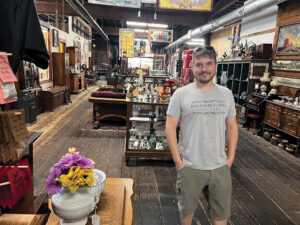
Matt Yegge, manager of Raccoon Forks Trading Company, said Railroad Bill’s Dining Car, which is attached to the antique store, drives customers into the store.
The antique industry in the United States expanded by 3.3% between 2018-2023, according to market research firm IBISWorld. Changed spending habits in a post-pandemic world and a supply chain furniture shortage are offered as reasons for the increased traffic at antique stores. But are Des Moines area shops reflecting national numbers? CITYVIEW spoke with representatives from three local antique stores for their perspectives on the state of the industry.
Catering to their strengths
Suzie Fredregill opened a booth featuring her antique and vintage collection at the Brass Armadillo, hoping to make enough cash to take her kids to Disney World. It turned out to be a success. She then opened a booth at Found Things in Des Moines. Customers would leave her notes asking her to open a store. Why? Fredregill focused on a specific niche: 1950s, 1960s and 1970s, which she has maintained in her business, Funky Finds Vintage & Retro.
“I was born in the 1960s, grew up in the 1970s and 1980s,” she said. “This was my childhood. This was my past. And this is the stuff that made me feel good, and I think it’s the stuff that makes young people feel good because it’s what was in their grandparents’ home.”
For Fredregill, selling vintage and antiques is all about reliving happy memories.
“Everybody has a story about everything in here,” Fredregill said.
To help recreate memories, Fredregill has her store arranged in “vignettes,” small displays organized by theme, such as kitchen, music, toys, paper goods and office.
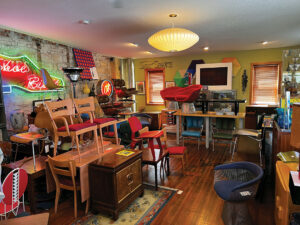
Antique signs, lighting, furniture and decor are among the items found at A Okay Antiques.
“The goal with the vignettes was to help customers see that there are ways that all of this plays really well together,” she explained. “It’s one of the things our customers remark about all the time — they love how things are set up. And they just appreciate the time that goes into creating an environment that brings up good feelings for them.”
Raccoon Forks Trading Company also uses themed groupings for its displays. Its themed rooms are based on time periods. Categories include Midcentury Modern, Primitives, Victorian and the Arts & Crafts Movement. They also have a room dedicated to books, prints and fine art and another for vinyl.
“Vinyl records has been one of the biggest items for us,” said Matt Yegge, manager. “We’ve been selling a crazy amount of vinyl records. Each month we’re doing better, and we’re continuing to build a reputation for our records, too. That’s been one of the most consistently popular rooms in the entire store.”
Raccoon Forks Trading Company is an antique store and a Raccoon Forks Microbusiness owned and operated by Optimae LifeServices. Another one of the microbusinesses, Railroad Bill’s Dining Car, is attached to Raccoon Forks and drives customers into the store.
It also sets the antique store apart from others.
“We’re the only spot that I can think of in Des Moines and Polk County that has a diner connected to their antique store,” said Yegge. “Saturdays and Sundays are always the busiest for breakfast time, and we’ll get people waiting in the lobby. So, while people are waiting for a table, they’re often wandering around the store listening to music and checking things out.”
Steve Mumma, owner of A Okay Antiques, says the store’s biggest strength is its location.
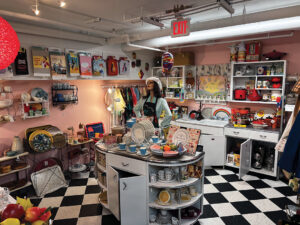
More young people are shopping at Funky Finds Vintage & Retro, says owner Suzie Fredregill as retro items have grown in popularity.
“We’re in the heart of Valley Junction. It’s an amazing business district, and it brings a lot of customers from around the world.”
He remembers when West Des Moines’ Historic Valley Junction looked a little different.
“Valley Junction used to have over 20 antique shops,” he said. “People would always ask me, ‘Doesn’t that make a lot of competition?’ It really doesn’t. It brings a lot of buyers to the area.”
Another thing that Mumma says sets his shop apart is A Okay’s estate and tag sales services. He said, often when people are downsizing, they have a home full of items they have accumulated over 30 to 40 years.
“Sometimes they’re not sure exactly where to start,” said Mumma. “We come in, and we sort it, advertise it, photograph it, and then we sell the contents, whether it’s fine art, jewelry, sculpture, household belongings, tools or vehicles. We’re there to sell it all, so it’s a great service for a lot of people that need that kind of help.”
Customer base
One of the biggest customer groups for antique stores has traditionally been collectors. Yegge explained that Raccoon Forks Trading Company, like other antique stores, does its best to carry items unique enough to stop a collector.
But a group visiting antique shops more frequently these days is young people.
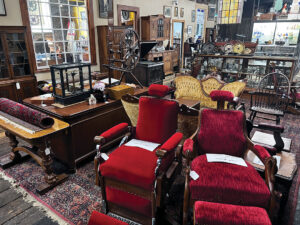 “We’re seeing more and more young people than we’ve ever seen before,” said Fredregill, of Funky Finds. “The little ones are particularly interested in typewriters and rotary dial telephones because they don’t know how to call their own telephone number on a rotary.”
“We’re seeing more and more young people than we’ve ever seen before,” said Fredregill, of Funky Finds. “The little ones are particularly interested in typewriters and rotary dial telephones because they don’t know how to call their own telephone number on a rotary.”
She added, “Young people starting out buying their first apartments come in here to shop because the forever furniture stuff that lasts for 60 years and will last another 60 years, they can attain it very affordably, and it’s going to last.”
It’s a phenomenon that is seen industry wide.
“Another big audience honestly is younger,” agreed Yegge. “You get people that are buying their first homes, and you get people that might be redoing their homes after 30 years.”
“The younger crowd likes ‘newer’ inventory, which would be 1960s, 1970s, 1980s,” commented Mumma.
The influence of technology
Those in the industry say it is easier than ever before to authenticate and price antique merchandise.
“Just by having a phone in your pocket, it helps a lot. You could just Google it and do a lot of research that way,” said Mumma.
Yegge uses a website called 1st Dibs to help price his high-end goods; otherwise, he uses Google Sales and eBay.
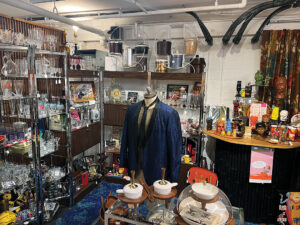 “We’ll cross reference pricing from different websites and then part of it is a gut feeling, too,” he said. “Some things you look up online, and it sold in Chicago for $2,000. We’re in Des Moines. So maybe I might sell it for $1,200.” It all depends on what the customer is willing to pay.
“We’ll cross reference pricing from different websites and then part of it is a gut feeling, too,” he said. “Some things you look up online, and it sold in Chicago for $2,000. We’re in Des Moines. So maybe I might sell it for $1,200.” It all depends on what the customer is willing to pay.
Customers are doing more research and buying online, said Yegge.
“A lot more people are selling on Marketplace, doing their own sales,” says Yegge. “People have become their own picker, their own specialist.”
Yegge says there is more saturation — more independent enthusiasts selling online who might cause an industry challenge.
But Fredregill and Mumma disagree.
“I think it’s great for us in terms of marketing because we can reach larger groups of people,” said Fredregill.
“Having Marketplace and Facebook out there and other online venues makes it easier to do business,” Mumma said. “We sell a lot to people who have online venues. I think it really helps. It makes it a lot easier to conduct business because you know everyone has a platform that they choose to sell on.”
Catering to trends
As with any business, trends can be difficult to predict.
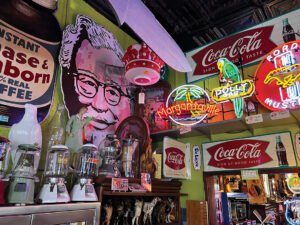 “Several years ago, when Pinterest became very popular and people did weddings with suitcases, we couldn’t keep suitcases in the shop at all,” Fredregill said. “Trends are changing in vintage clothing now. It is much more focused on 1970s and boho and prairie style clothing, so those are the first things that sell rather than the early 1950s, ‘I Love Lucy’ housewife clothing that typically sold super well. So, we do see trends happen. We don’t know exactly what is setting those trends, but we’re on board because that’s our niche.”
“Several years ago, when Pinterest became very popular and people did weddings with suitcases, we couldn’t keep suitcases in the shop at all,” Fredregill said. “Trends are changing in vintage clothing now. It is much more focused on 1970s and boho and prairie style clothing, so those are the first things that sell rather than the early 1950s, ‘I Love Lucy’ housewife clothing that typically sold super well. So, we do see trends happen. We don’t know exactly what is setting those trends, but we’re on board because that’s our niche.”
Raccoon Forks Trading Company has a separate warehouse to store items that are not selling.
“We’ve got another warehouse full of stuff so we’re able to constantly circulate what we have,” explained Yegge. “So, if something’s on the floor for a few months and hasn’t sold, we can put that back in the warehouse and bring something else in.”
Mumma prefers to buy things that personally appeal to him.
“I really buy what I like,” he said. “I just hope somebody else feels the same way about it.”
Time will tell
While IBISWorld suggests that growth in antique sales may level off as pandemic turmoil fades and new furniture supplies rebound, only time will tell if the new customers cited by local antique store owners will become long-term regulars. For now, owners play to the strengths of their individual stores and do what successful businesses must do: respond to the changing demands of customers. ♦





















